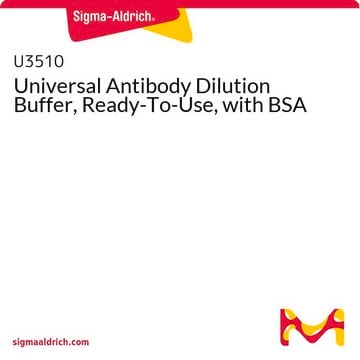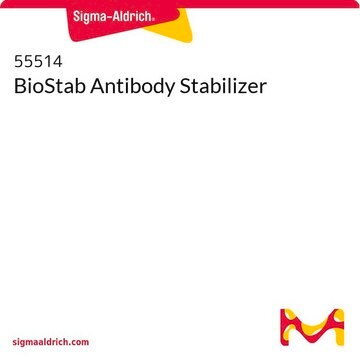U3635
Universal Antibody Dilution Buffer
Iniciar sesiónpara Ver la Fijación de precios por contrato y de la organización
About This Item
UNSPSC Code:
12352107
NACRES:
NA.47
Productos recomendados
pH
7.3-7.5
application(s)
hematology
histology
storage temp.
room temp
General description
Ready to use buffer for dilution of antibodies in all immunoassays. This buffer does not contain any mammalian proteins, phosphate, sodium azide or mercury preservatives and can be used for dilution of all antibodies, including peroxidase conjugates and antibodies to phosphoproteins. Not suitable for dilution of antibodies to S100 proteins.
Application
For dilution of primary or secondary antibodies. The diluted antibodies can be stored at 2-8 °C for several weeks in this buffer.
Universal Antibody Dilution Buffer has been used in immunoblotting.
signalword
Warning
hcodes
Hazard Classifications
Aquatic Chronic 3 - Skin Sens. 1
Storage Class
12 - Non Combustible Liquids
wgk_germany
WGK 2
flash_point_f
Not applicable
flash_point_c
Not applicable
Certificados de análisis (COA)
Busque Certificados de análisis (COA) introduciendo el número de lote del producto. Los números de lote se encuentran en la etiqueta del producto después de las palabras «Lot» o «Batch»
¿Ya tiene este producto?
Encuentre la documentación para los productos que ha comprado recientemente en la Biblioteca de documentos.
High level of calpain1 promotes cancer cell invasion and migration in oral squamous cell carcinoma.
Ma D, et al.
Oncology Letters, 13(6), 4017-4026 (2017)
Zhihui Li et al.
Cell biology international, 46(10), 1672-1681 (2022-07-14)
Bladder cancer (BC) is a common urological malignancy that still lacks an effective treatment. Doxorubicin (Dox) has been widely used in the treatment of various cancers, including BC. However, chemoresistance often hampers the clinical application of Dox, therefore, it is
Caitlyn Fastenau et al.
GeroScience, 45(3), 1539-1555 (2023-03-04)
Terminal sialic acid residues are present on most glycoproteins and glycolipids, but levels of sialylation are known to change in the brain throughout the lifespan as well as during disease. Sialic acids are important for numerous cellular processes including cell
Caitlyn Fastenau et al.
Brain pathology (Zurich, Switzerland), 34(4), e13267-e13267 (2024-05-10)
Glycosylation is the most common form of post-translational modification in the brain. Aberrant glycosylation has been observed in cerebrospinal fluid and brain tissue of Alzheimer's disease (AD) cases, including dysregulation of terminal sialic acid (SA) modifications. While alterations in sialylation
Da Ma et al.
Oncology letters, 13(6), 4017-4026 (2017-06-08)
Calpain1, termed conventional calpain and a member of the Ca2+-dependent neutral cysteine proteases, is considered to be involved in cancer formation and development. However, the effect of calpain1 on oral squamous cell carcinoma (OSCC) remains poorly understood. The aim of
Nuestro equipo de científicos tiene experiencia en todas las áreas de investigación: Ciencias de la vida, Ciencia de los materiales, Síntesis química, Cromatografía, Analítica y muchas otras.
Póngase en contacto con el Servicio técnico








